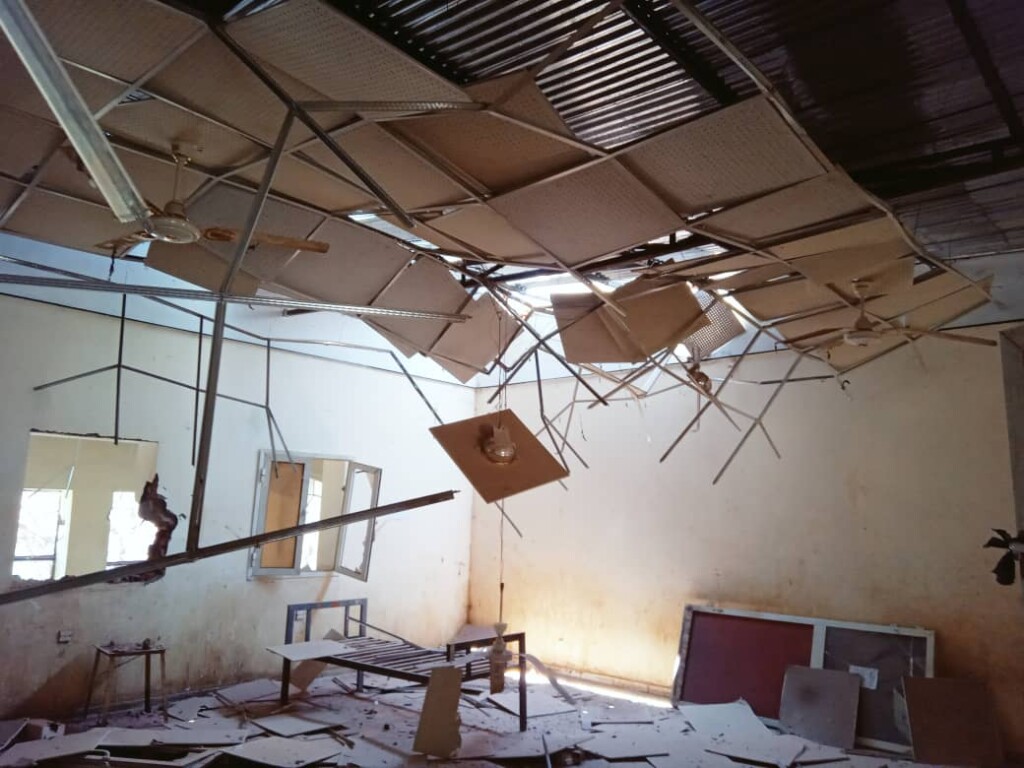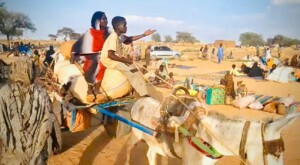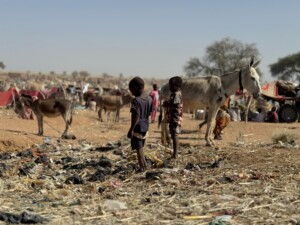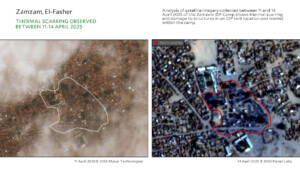Battles continue in Sudan, air raids on East Darfur hospital kill four

A ward of the teaching hospital of Ed Daein, the capital of East Darfur, yesterday (Photo: El Taghyeer newspaper)
Four people were killed in aerial bombardments on Ed Daein, the capital of East Darfur, yesterday. El Taweisha and Mellit in North Darfur were bombed on Monday. The Rapid Support Forces (RSF) shelled the eastern part of El Fasher. Fighting also continued in Khartoum, El Gezira, and North and South Kordofan.
Four people were killed and at least 12 injured in airstrikes by the Sudanese Air Force on Ed Daein yesterday.
Speaking to Radio Dabanga from Ed Daein, a woman reported that the Sudanese Air Force targeted the Ed Daein Teaching Hospital and the kidney dialysis centre, the city’s main market, the Grand Mosque, and El Khansaa Elementary School for Girls.
“The airstrikes targeted vital sites where there are no RSF soldiers present,” she said, and called on the international community to impose a no-fly zone over Darfur, “to avoid civilians being hit until peace has returned to Sudan”.
Activists on social media posted videos and photos documenting the dead and wounded in the hospital and market of the East Darfur capital that was occupied by the RSF in December last year.
North Darfur
On Monday, warplanes bombed the North Darfur towns of El Taweisha and Mellit, which are under control of the RSF. The bombardments on El Taweisha caused an unknown number of deaths and injuries.
No casualties were reported from Mellit, occupied by the RSF in April. The airstrike, the second of its kind in ten days, destroyed the buildings of the Water Corporation, the Forestry Office, and damaged several houses in the vicinity, a listener told Radio Dabanga from the town.
He said that during the past few days, the Sudanese Air Force also attacked several other areas in North Darfur, including El Malha, and intensified its air raids on the outskirts of El Fasher, the capital of North Darfur, which is for a large part still in the hands of the army.
The RSF is in control of four of the five Darfur states. In October last year, the paramilitaries occupied Nyala and Zalingei. A month later, the paramilitaries seized El Geneina and Ed Daein. They also control most parts of North Darfur except its capital El Fasher*.
RSF artillery shelling on El Fasher since Sunday evening led to the destruction of medicine stores belonging to Relief International Relief.
The attacks continued yesterday morning, concentrating on the eastern side of the city, a listener reported. He said that the SAF “responded to the source of the bombing,” and added that a cautious calm prevailed in the city in the afternoon.
Other places
Yesterday, SAF reported on its Facebook page that its special forces of the Armoured Corps in Khartoum have made significant advances, “liberating more areas and securing new positions” around the El Doha Park neighbourhood west of the police station of Jabra in southwest Khartoum.
People living in Omdurman reported that the RSF shelled targets in Karari and El Waha in northern Omdurman and El Shuhada in the centre of old Omdurman on Sunday evening.
Yesterday, the RSF posted a video clip on its X account about the destruction of homes by airstrikes in Omdurman’s Ombadda.
On Friday, at least nine people died in air raids by the Sudanese Air Force on rural Khartoum Bahri (Khartoum North). At least 30 people, among them many children, were killed in RSF attacks on villages in Sennar and El Gezira.
The SAF said on its Facebook page on Sunday that its soldiers, “along with other regular forces and volunteers, successfully carried out a series of special operations” in El Gezira, “crushing the terrorist Rapid Support militia (Janjaweed)”.
Army troops also attacked RSF sites near El Obeid, the capital of North Kordofan, “which resulted in losses among their ranks and the seizure of weapons and vehicles,” the SAF stated.
The RSF reported on Sunday that it captured more than 100 Ethiopians from Tigray allegedly fighting for the SAF in El Fao in western El Gedaref.
Southern Sudan
On Saturday, clashes broke out between SAF troops and fighters of the Sudan People’s Liberation Movement-North under the command of Abdelaziz El Hilu (SPLM-N El Hilu) in the Kador area, near Delling in South Kordofan. The area is controlled by the movement.
Sources reported from Delling that SAF warplanes had accidentally dropped military supplies in an SPLM-N camp, which led to fierce clashes between the two parties.
A rebel leader denied that the army took control of the site, but the sources stated that the SAF took control of the Kador rebel camp after 10 hours of fighting.
In neighbouring Blue Nile state, people are expecting an invasion of the RSF, after RSF commanders in the region threated the SAF on social media, telling them to withdraw from Ed Damazin, the capital of Blue Nile state, and demanded from native administration community leaders to intervene and convince the army to leave the area “to spare them the danger of battles”.
Last week, the RSF posted two video clips containing direct threats about an attack on Blue Nile state. If the paramilitaries succeed in occupying Blue Nile state, they will have gained a strategically very important region**.
The SPLM-N El Hilu recently declared famine in the areas under its control in South Kordofan and Blue Nile state, including areas controlled by Yousef Tuka in southern Blue Nile state.
* The RSF have gradually expanded their areas of control in North Darfur since the beginning of the war on April 15, 2023. While attacking the other four Darfur states in the second half of last year, the paramilitaries also gained control over most of the localities in North Darfur, including El Sareif Beni Hussein, Saraf Omra, Kabkabiya, Kutum, El Koma and El Waha. In April this year, they seized Mellit. The area of Tawila is still controlled by forces of the mainstream Sudan Liberation Movement headed by Abdelwahid Nur (SLM-AW).
The SAF and the Darfur Joint Force still control a large part of El Fasher, including the Grand Market and government institutions in the western part of the city, and the military base in the south. The RSF paramilitaries are mainly positioned in the eastern and southern outskirts of El Fasher and have previously attempted to breach the army and joint force defenses from the north. They rely on tactics of attrition through repeated artillery shelling on the city from several axes at spaced intervals with the aim of exhausting the army and its allies.
The first battle for El Fasher city took place in mid-April last year and resulted in a ceasefire that held until 12 May. That day clashes broke out again, which ended 16 days later with a more stable ceasefire that lasted until August, thanks to the efforts of the then North Darfur Governor Nimir Abdelrahman, imams and community leaders. By September, the city had become a haven for displaced across the region, without enough water and food supplies.
Security conditions in El Fasher deteriorated rapidly in late October as violent clashes erupted again between the two parties and led to mass displacement. An estimated 85 per cent of the population of the city’s northern neighbourhoods, including the Abu Shouk and El Salam (Abuja) displaced camps, fled their homes. Renewed SAF-RSF battles erupted in the city in February, with many fearing a “catastrophic bloodbath” in the area. The RSF taking full control of the city would reportedly also ignite strife between the Arab tribes supporting the RSF and the Zaghawa tribe, from which most North Darfur rebel fighters hail.
** Blue Nile state
The RSF paramilitaries are now deployed in a semi-circle north of Ed Damazin, extending from areas in Sennar‘s El Dinder, located northeast of Ed Damazin, El Suki in the north, and in Blue Nile’s El Tadamon in the west. The Sudanese army is stationed in Ed Damazin and in Baw, which was previously controlled by fighters of the SPLM-N faction of Malik Agar, and the Gali area, while the SPLM-N El Hilu is present in the southern areas surrounding Ullu, Kurmuk town, and Yabus. On August 1, renewed clashes between the SPLM-N El Hilu faction led by Yousef Tuka and the SAF erupted in Dindiro town in northern Kurmuk.
Blue Nile state shares borders with Ethiopia and South Sudan, which would allow the RSF, if they master the region, to dominate the entire border with South Sudan, except for the areas controlled by the SPLM-N El Hilu in Blue Nile and South Kordofan. Access to the border with Ethiopia would also provide a nearby logistical support outlet that reduces reliance on support coming from Sudan’s western border.
The southeastern Sudanese state is very rich in chromium, gold, copper, magnesium, marble, and cement. Furthermore, it contains the El Roseires Dam, which controls irrigation in the El Gezira Agricultural Scheme, and is an important sources of cheap electricity for large areas in Sudan.











 and then
and then